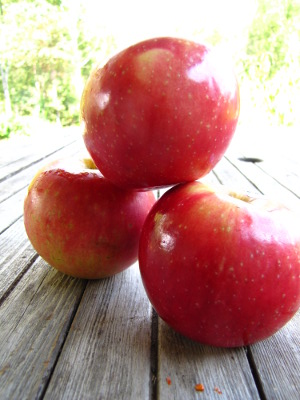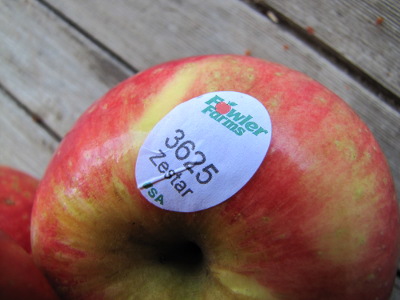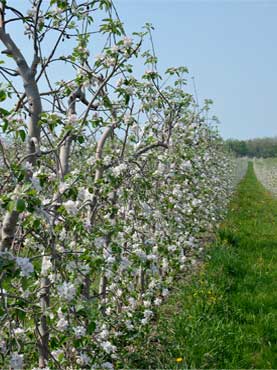
Is it the apple or the tree?
 Mark
likes apples the way I like peaches --- he figures even a substandard
apple is better than nothing. While I wait for the Winesaps to
show up at the fruit stand, he works his way through supermarket
apples, trying variety after variety in hopes that one will finally
make the cut.
Mark
likes apples the way I like peaches --- he figures even a substandard
apple is better than nothing. While I wait for the Winesaps to
show up at the fruit stand, he works his way through supermarket
apples, trying variety after variety in hopes that one will finally
make the cut.
And, to my astonishment,
one did. The Zestar apples Mark brought home from the grocery
store last week taste like homegrown, unpasteurized apple cider, but
with the crisp crunch Mark craves. Sweet and sour at the same
time, the variety even won me over!
But was it the apple or
the tree? Always the sleuth, I was struck by the Zestar's
sticker,  which
wasn't as slick and professional looking as usual. It turns out
our Zestars came from a family farm in New York state that's been in operation for
150 years. There, apples are grown using a method that I'd never
heard of before --- the super spindle system.
which
wasn't as slick and professional looking as usual. It turns out
our Zestars came from a family farm in New York state that's been in operation for
150 years. There, apples are grown using a method that I'd never
heard of before --- the super spindle system.
This system (and its
relatives, the tall spindle, slender spindle, and vertical axis) uses
dwarf trees and crams them so close together they're mere vertical
sticks. In addition to bearing quickly (you can expect 15 to 20
apples the second year), trees planted in the super spindle  system
don't shade any part of the tree, so fruits get full sunlight that
leads to optimal flavor.
system
don't shade any part of the tree, so fruits get full sunlight that
leads to optimal flavor.
Like any orchard system,
super spindle has its downfalls --- in this case, fiddliness. I
haven't had any luck with dwarf fruit trees in the past, which I
suspect is because I expected them to live in poor soil areas without
irrigation. When you plant trees two feet apart in the super
spindle system, you have to treat your orchard like a high value
vegetable garden, giving it constant care.
But those Zestar apples
tasted so good, and I have a spot just the right size to try a row of
super spindle apple trees. So I think I'll give it a shot ---
stay tuned for more data on the system as it progresses!
Want more in-depth information? Browse through our books.
Or explore more posts by date or by subject.
About us: Anna Hess and Mark Hamilton spent over a decade living self-sufficiently in the mountains of Virginia before moving north to start over from scratch in the foothills of Ohio. They've experimented with permaculture, no-till gardening, trailersteading, home-based microbusinesses and much more, writing about their adventures in both blogs and books.
Want to be notified when new comments are posted on this page? Click on the RSS button after you add a comment to subscribe to the comment feed, or simply check the box beside "email replies to me" while writing your comment.

Irma --- You can't stop there. What did you think of the farm, the apples, the farmers?
Tisha --- The one thing I'm concerned about with Zestar is that they're not as resistant to cedar apple rust as some varieties are. That probably isn't a problem in your low humidity location, though!
Mom --- I do have reservations about the system, although not about the spirituality of the tree. In addition to requiring monthly supervision, dwarf tree roots are much less extensive, so the trees aren't going to reach as widely to find micronutrients, which could affect flavor. I figure it's worth experimenting with, though, especially since I've run out of room for full size trees unless I start clearing more of the woods.
Maggie --- Don't give me too much credit. I'm still researching, and I won't really know what I think for maybe five or ten years, until I can harvest an apple from a semi-spindle and one from a semi-standard tree from our same yard and compare and contrast. (That makes me think I should use some of the same varieties in the two places. Hmmmm....)
I'm still researching, and I won't really know what I think for maybe five or ten years, until I can harvest an apple from a semi-spindle and one from a semi-standard tree from our same yard and compare and contrast. (That makes me think I should use some of the same varieties in the two places. Hmmmm....)
"Oh, the Lord's been good to me. And so I thank the Lord For giving me the things I need: The sun, the rain and the appleseed; Oh, the Lord's been good to me"
We own a small apple orchard and this is our kids favorite prayer. Your post reminded me of it
Zestar is a new release from the University of Minnesota. They limited the orchards allowed to grow it and seriously limited distrbution the first two years of commercial release. The orchards local to the UofM had a fit! They said they were only willing to work with established orchards that were willing to grow it in a "certain way" on "good soil" etc. etc. that would bring out the "best flavor" ie the commercial success of the "zestar" brand name because the U of M paid for patent an license on all of the above were the primary goal.
Not to disrespect their breeding program nor the skill of their hort. dept. but that there are some serious commercial goals behind zestar. It is, a zone 3/4 hardy apple and one that has been very quickly added to the repertoire of growers around here. If you can get ahold of prairie spy, I'd highly recommend that. Most nurseries have "northern spy" but not "prairie spy" It's a very crisp apple with a couple of different levels to its flavor and is a definite winter keeper - holds well in a root cellar. Might find it with a local grower, never at the supermarket. Well worth the time to grow, and a step up from honeycrisp, rivalling pink lady in my mouth...
Its the Apple tree, silly!
If there is one thing I have learned from growing apples in Florida; its the whole tree that needs to be considered. Your apple variety and your m111 rootstock of course.
If your going to stick your apple on some poor sorry excuse of a rootstock, your going to pay for that in major TLC. One dry spell, one bug attack, your trees will be hard pressed just to survive with all your care. Dwarf roots are bred for one thing. High yield(poor quality),dead orchards. Where everything can be pumped onto the small root zone, and sprays distributed evenly throughout the thin rows.
The thing is, you don't have to use dwarf roots to keep your trees small. Even on near standard roots, like m111, you could easily keep your trees under 8 feet and as narrow as you want with prunning. You keep the hardiness and adaptability though.
All of my trees are on m111, and I don't use a ladder to harvest them. My closest plantings are just 4 feet apart, flat against a fence.
With good roots, come good apples!
Looks like a modified Espalier pattern except the trees are much closer together like you described. This is what I'm currently planning all the way around my fence. From talking to growers and my research, this is the best way for me to utilize my 1/2 acre yard.
I just found a horse farm with 30 yards of horse manure/compost that is aged from 2-8 years with about 20 yards of 0-1 year old manure also. I'm dieing to start getting my truck over there and hauling it all in!
I love seeing so many differing points of views on the method! I suspect you're all right, at least in part. Here are a couple of specifics that jumped out at me:
Here are a couple of specifics that jumped out at me:
C, I was struck by your note that the University of Minnesota is only allowing orchards with "good soil" to grow Zestar. Although I can see why certain orchards would be pissed off, I can totally understand that --- it could be the soil more than the variety or the tree I'm tasting.
T, My experience with dwarf trees has lined up with what you've said. (Although I've only tried two trees in the past, so my sample size is small.) But I've also never treated a dwarf tree like part of the vegetable garden rather than like, well, a tree. I should probably see if I can squeeze in a few full-size trees in my spindle planting to compare and contrast.
I should probably see if I can squeeze in a few full-size trees in my spindle planting to compare and contrast.
Anna - I think the trouble with the U of M restrictions might be settled and the restrictions might be lifted by now. I do think that there was quite enough of a backlash to put the heat on their bumms to make them offer it up to more nurseries and more orchards.
I do apologize for the link in the subject line of my previous post, obviously I was copy/pasting for a totally different subject matter and missed that I'd made a mistake here. Please feel free to remove it.